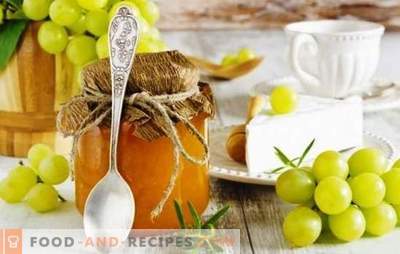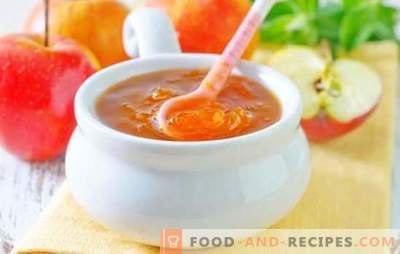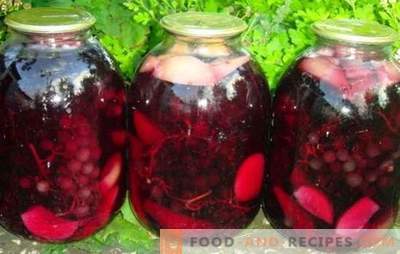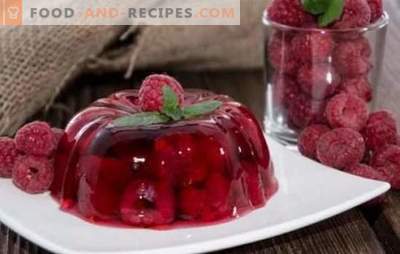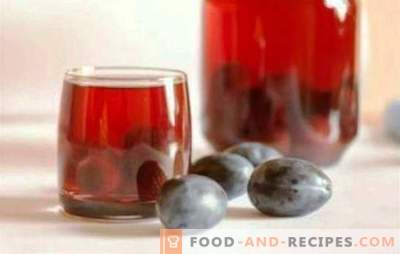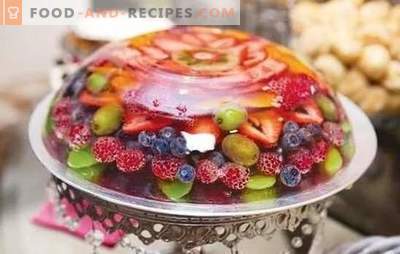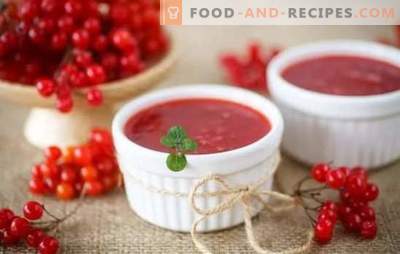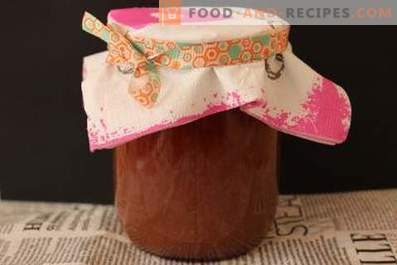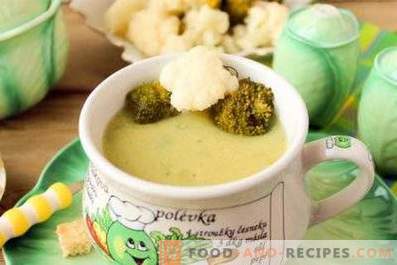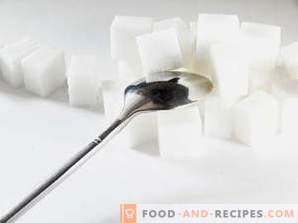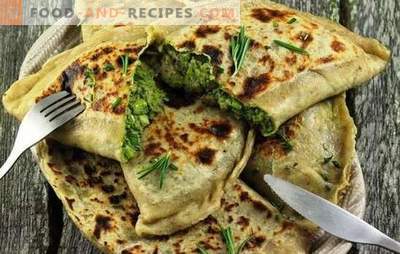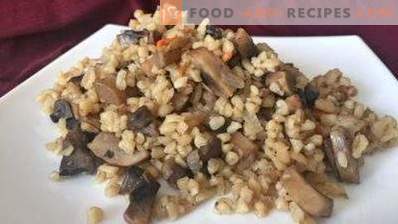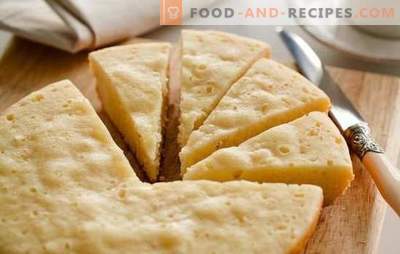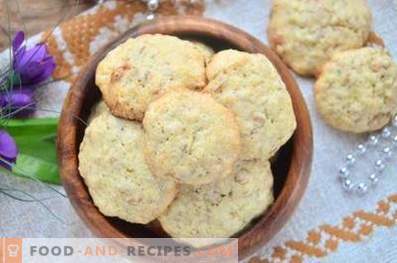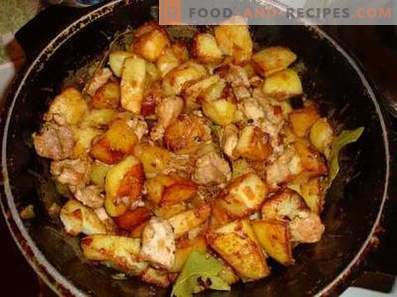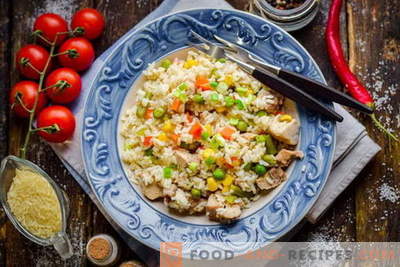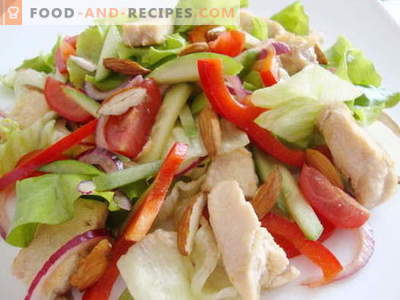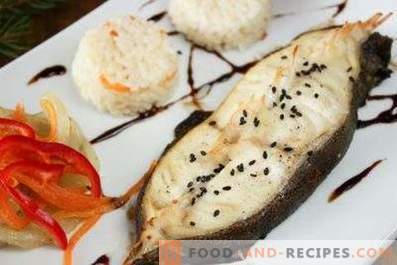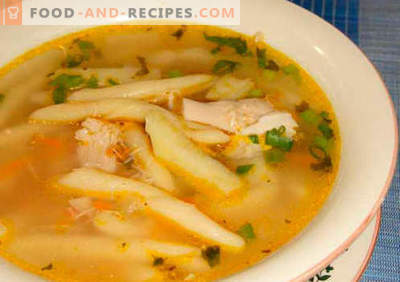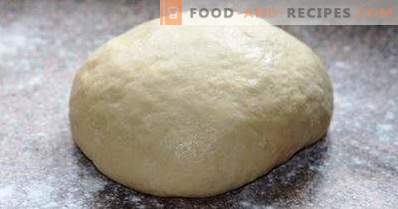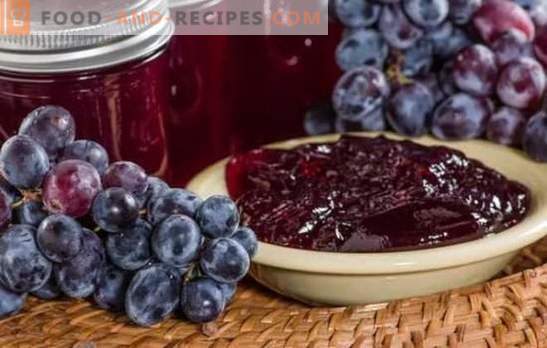
Grape jelly is a tasty piece of summer, reserved for future use, which is, in its simplest form, grape juice boiled to thickness with sugar, rolled into sterilized jars.
Winter Grape Jelly: Basic Principles
For its preparation, table grapes are used and jelly is usually prepared from any one variety, not mixing them together, but it is bright to combine grapes with other fruits (peaches, apples, pears, cherries ...) and berries (raspberries, currants ... ).
So, jelly from grapes for the winter, is the same open space for culinary imagination, as well as jam, jams, marmalades and so on.
Preparation of any jelly from grapes for the winter begins with the fact that the berries are cut off with brushes, sifted, removing damaged, washed in running water and dried, leaving in a colander, which is shaken several times.
Grape Jelly Classic
Ingredients
· 3 kg of grapes (recommended variety Isabella);
· 1.5 kg of sugar;
· 300 ml of water.
Cooking
· Boil water in the pot, put the grapes in it, reduce the heat to medium and warm the grapes, waiting until it becomes softer, the skin begins to crack;
· Set aside the pan, wait until the grapes have cooled, mash it with a tolkushka and, putting it on a multi-layer gauze (it is more convenient to do it in small portions), carefully squeeze the juice out of it
· Pour the grape juice into the pan and return the dishes to the stove;
· Having started to warm up the juice, slowly pour sugar, stirring it so that it is well dissolved;
· Watch how the juice is boiled in jelly until its volume is approximately halved and be sure to remove the froth from the brew;
· Arrange the burning hot jelly in jars.
Grape Jelly from Freshly Squeezed Juice
Ingredients
· 2 kg of grapes;
· 1 kg of sugar.
Cooking
· Squeeze the juice out of the grapes using a juicer; · Pour the juice into the saucepan and, putting it on medium heat, add sugar gradually, stirring vigorously for better dissolving;
· Add heat, bring the juice to a boil, then reduce it and, removing the foil that forms from above, boil it until thick, until the jelly becomes half as much;
· Put the blank in prepared jars.
Grape Jelly Puree with Cinnamon
Ingredients
· 3 kg of dark grapes;
· 1.5 kg of sugar;
· Cinnamon to taste;
· Citric acid to taste;
· 200-300 ml of water.
Cooking
· Pour one third of the sugar into a saucepan with water and, while stirring continuously, bring the syrup to a boil;
· Add grapes to the dishes, mix everything and reduce the heat, leaving the berries to languish in syrup for 15-20 minutes;
· Set aside the saucepan, let it cool and wipe the berries twice through a sieve;
· Put the mashed potatoes in a saucepan with the syrup, return the dishes to the fire and start to boil down, slowly, with constant stirring, adding sugar;
· When sugar dissolves, add cinnamon to taste and, every now and then removing skins, boil down the sweet mass in anticipation of the moment when its volume decreases by half;
· Shortly before the readiness, add a little citric acid to the jelly from the grapes for the winter, after which, distribute the still hot billet in jars.
Grape Jelly with Oranges
Ingredients
· 2 kg of grapes;
· 1 kg of oranges;
· 1 kg of sugar;
· 1 bag of pectin;
· 100 ml of water.
Cooking
· Peel oranges from skins, zest and seeds, put them in a saucepan, pour in water, add grapes and put the dishes on medium heat, cover with a lid;
· In 30-40 minutes, remove from heat and let cool;
· Pour the liquid from the fruit into separate dishes;
· Rub the fruit through a sieve and squeeze the resulting mass through a multi-layer gauze;
· Add the squeezed portion of the juice to the one that just drained and pour everything back into the pan;
· Put it on the stove, start to heat and pour sugar, stirring it so that it is well dissolved; · Add pectin, stir and bring the liquid to a boil;
· Turn down the heat and wait for the jelly to rapidly thicken and reduce its volume by half;
· Distribute jelly in jars.
If you want to try a more exotic version of grape jelly for the winter, replace from one-quarter to one-third of regular sugar with cane sugar, with which the jelly will acquire unusually savory, caramel notes.
Grape Jelly with Raspberries and White Wine
Ingredients
· 2 kg of red grapes;
· 1 kg of raspberry;
· 200 ml of white sweet wine;
· 2 cinnamon sticks;
· 1 kg of sugar;
· 150 ml of water.
Cooking
· Grapes and raspberries, white wine, water and cinnamon sticks - put everything in one pan;
· Cover it with a lid, turn on a small fire and leave on the stove for 50-60 minutes;
· Set aside, remove the cinnamon and allow the mixture to cool;
· If you want to get a transparent jelly - put a colander in a deep dish and, knocking the contents of the pan into it, wait until all the liquid has drained;
· If transparency is not critical - after the liquid has drained, select raspberries, wipe puree through the sieve and connect it with juice and wine, sent to the plate again;
· Add sugar to the saucepan, in small portions, stirring until the final dissolution;
· Continue to boil the jelly until it thickens about two times, carefully removing the foam that forms;
· Spread the grapes jelly that has not yet cooled down for the winter, in jars;
Grape Jelly with Apricots, White Wine and Walnuts
· 1 kg of white grapes;
· 1 kg of apricots;
· 200 ml of sweet white wine;
· 1 kg of sugar;
· 100 ml of water;
· 300 g peeled walnuts.
Cooking
· Putting the saucepan on the stove, pour water, white wine into it, put the halves of seedless apricots and grapes;
· Cover and leave to stew, stew for 40-50 minutes;
· Next, remove from heat, cool to a suitable temperature and wipe the fruit twice through a sieve, add the grated to the liquid;
· Put walnuts and sugar in a dry pan with a non-stick coating, in approximately equal proportions; · Turn on a small fire and stir the nuts in sugar with a spatula, warming up to the state when the caramelized sugar peels the nuts, after which the pan can be set aside and returned to the jelly;
· Place the saucepan with mashed potatoes and juice on the stove and add sugar, stirring it thoroughly until dissolved, then boil down everything until it thickens and reduces by half;
· Distributing jelly from grapes for the winter in cans, add to each of them a portion of nuts in caramel.
Grape Jelly with Apples and Pears
Ingredients
· 0.5 kg of pears;
· 0.5 kg of apples;
· 2 kg of grapes;
· 2 kg of sugar;
· 0.5 tsp. soda;
· 1 tsp. citric acid;
· 2 bags of pectin.
Cooking
· Peel pears and apples with seeds and cut them into slices;
· Fill the fruit with 0.5 l of cold water, with soda dissolved in it and leave it for 3-4 hours. Due to this, the lobules will not be boiled out during the cooking process and will be more interestingly felt by the texture in the planned blank;
· Squeeze juice on a juice extractor;
· Pour the juice into the pan, put on a low heat, start heating, add half the amount of sugar;
· When sugar dissolves - add pectin, mix well and wait for boiling;
· Boil the mixture for a few minutes, wait until boiling again (but do not boil!), Add citric acid, dissolve, stirring, and remove the pan from the stove;
· Drain the soda solution from the fruit slices and rinse them well with cold water;
· Pour 200-250 ml of water into another saucepan, add the remaining sugar, dissolve it and bring the syrup to the boil, put the fruit in the bowl;
· Boil them on medium heat for 15-20 minutes, stirring gently;
· Pour the contents of the saucepan with grape juice to the fruit, mix and bring everything to a boil again;
· Finally, place the hot jelly in jars.
Grape jelly for winter: secrets and tricks
Despite the variety of grape jelly recipes in the world for the winter, some of the tricks of home cooking are applicable to all of them, providing a dizzyingly tasty and useful result for the hostess’s hassle. 1. Jelly from grapes for the winter, as well as jams, jams, confitures, etc., is recommended to be cooked in thick-walled dishes, which evenly distribute heat over the entire surface, at the bottom of which food is unlikely to burn.
2. Grapes should be ripe, it is permissible - a little unripe, but never - overripe, one in which the characteristic taste of fermentation is felt.
3. Grape juice will be cleaner, more transparent if allowed to settle and after filtering through several layers of gauze, carefully pouring it out of the container so as not to disturb the sediment.
4. There are enough gelling substances in grapes, but not in excess, so pectin, gelatin or agar-agar are sometimes added to jelly.
5. The amount of sugar, as well as the quantity and range (and generally necessary) of various additives, varies from personal tastes and grape varieties. The high sugar content of the grapes suggests that the sugar must be placed smaller and, perhaps, the jam of the jelly should be reduced by lemon juice or citric acid. Bright taste and aroma of some varieties do not need to be decorated with spices and other fruits, while other varieties, on the contrary, are neutral in taste and are good as a basis for culinary experiments on harvesting grape for the winter.
6. To check the readiness of the jelly, you need to throw a drop of it in a bowl of water - if it sinks to the bottom it does not dissolve, then it’s done.
Delicious grape jelly can be served with tea, pancakes, cheesecake, toast, porridge, used to make sweet drinks and desserts, original main dishes.

